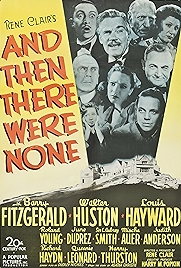There have been many, many adaptations of Agatha Christie’s novel And Then There Were None, but for pure, straightforward storytelling at pace, it hard to beat this one, from 1945.
It writes the book on the “elimination whodunit”, when one character after another is killed, with Christie keeping the speculation going as to who actually did it right up to the point when there are only two possible choices left. As so often with Christie, she withholds some vital piece of information from the audience, and then delivers it at the end with a ta-daa flourish. This is exactly the sort of plotting that drives some people into Christie’s arms and others out of the room.
The director is René Clair, a Frenchman with a light touch, who did his best work in France but whose American output isn’t to be sneezed at. Look at the way he introduces his gaggle of victims-to-be, a boatful of people heading off to a mystery island, each one vignetted briefly by the camera, before the camera passes on to the next – a five minute sequence with no dialogue. There are eight of them on the boat, not including the skipper, who also gets a brief moment of scrutiny but who won’t feature again until the film’s dying moments.
On the island at the big house where everything is to play out, the group discover they have been gathered together by a man called UN Owen (“Unknown”) and that each is guilty of some crime. A judge, a doctor, a Russian prince, a general, a detective and a smattering of civilians. Plus a husband-and-wife housekeeper and butler. Ten people in all. Everyone with something to hide. All suspicious and given to snooping. It won’t be long before the dying starts. But who’s going to die first, how will they die, who’s doing the killing, and why?
It’s a lovely cast of character actor who crackle away like plastic egg boxes – Barry Fitzgerald, Walter Houston, Roland Young, C Aubrey Smith, Mischa Auer and Judith Anderson, plus pretty and bland June Duprez and Louis Hayward, who represent us normal people, while Queenie Leonard and Richard Haydn play “the help”.
There’s a suggestion on the wind that Christie lifted the structure and plot from a 1934 film called The Ninth Guest (good luck finding it to check), but it’s And Then There Were None that’s become canonical and it has been borrowed and adapted countless times since. It’s the basis of the recent Glass Onion: A Knives Out Mystery for instance – same guilty customers, same remote island location.
As in so many Christie adaptations, death is something to be desperately avoided, and feared, but it doesn’t seem to shock or psychologically scar anyone when it happens. As one after another dies by gun, knife, poison, axe, injection and so on, the survivors carry on betweentimes chatting brightly and tucking into hearty meals and drinks. See also Murder on the Orient Express and Death on the Nile.
It’s all frightfully, frightfully light-hearted, and director René Clair matches the slightly exagerrated performances with a camera that can at times be playful – ducking down to a keyhole when someone is snooping on someone else, or following an unravelled ball of wool up, up, up to where a dead body surely awaits.
Fitzgerald and Huston get the best of it, as the aged judge and the alcoholic doctor, and at times it threatens to become the Fitzgerald/Huston show, with Roland Young yapping at the edges as a detective whose lower social status gives the film some claim to be a social commentary, if you’re being generous (though the butler/housekeeper duo, the Rogers, make more of a claim).
Simply, it works. For all the intense formatting and repetitive structure, the plot is a good one and the tone is exactly where it should be – And Then There Were None is a case of murder most fun.
And Then There Were None – Watch it/buy it at Amazon
I am an Amazon affiliate
© Steve Morrissey 2023


